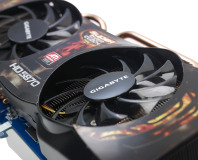Pixel Fillrate Performance
Tests
- Direct3D 9.0c: Fillrate Tester – Pixel Fillrate
- Direct3D 9.0c: Fillrate Tester – Z Pixel Filrate
- Direct3D 10: 3DMark Vantage: Colour Fill
Test Kit
- Intel Core i7 965 processor (3.2GHz: 133MHz x 24)
- Asus P6T V2 motherboard (Intel X58 Express)
- 6GB Corsair TR3X6G1333C9 DDR3 memory (3x 2GB, 1,333MHz, CL9)
- Corsair X128 SSD
- Corsair HX1000W PSU
- Windows Vista Home Premium x86-64 (with Service Pack 2)
- Antec Twelve Hundred Chassis
- HD 5870: Catalyst 8.66 RC6 Windows Vista/7 (September 11th Build)
- All other ATI: Catalyst 9.9 WHQL
- ] Nvidia: ForceWare 190.38 WHQL
Fillrate tests are typically memory bandwidth limited, and given that we had some concerns about the available memory bandwidth on the Radeon HD 5870, it's good to see that it gets very close to its theoretical peak of 27.2 Gigapixels per second in our basic fillrate test. By comparison, the GeForce GTX 285 is some way off its theoretical peak of 20.7 Gigapixels per second, while the Radeon HD 4890 manages to get within 0.6 Gigapixels per second of its peak throughput.
In terms of depth/stencil (Z-only) processing, the Radeon HD 5870 appears to bump into some memory bandwidth limitations, as it has twice the theoretical throughput of the 4890, but doesn't manage to deliver twice the 4890's depth/stencil fillrate. Moreover, neither RV790 (and by extension RV770) nor Cypress delivers its full Z-only fillrate in this test, so while AMD says capability for that may be there, we're not seeing it.
The theoretical peak for the HD 5870 should be in the region of 108.8 Gigapixels per second, so this test is running at nearer 96 pixels per clock on AMD's new GPU. What's interesting is that the GeForce GTX 285 manages to get close to its peak throughput, but it does have slightly more memory bandwidth available to it than the HD 5870 (159.0GB/sec rather than 153.6GB/sec).
This fillrate test uses interpolation and alpha blending to write an FP16 colour format directly to the render target, which is the most popular format used for HDR lighting. It generally ends up being more memory bandwidth limited than our previous fillrate test and, as a result, the results are bunched much closer together. The GTX 285 is slightly slower than the HD 5870 in this test, but not by a proportional amount. This shows the memory bandwidth limitations apparent in this test, but this limitation is almost impossible to avoid when calculating fillrate across a range of different colour formats.

MSI MPG Velox 100R Chassis Review
October 14 2021 | 15:04









Want to comment? Please log in.